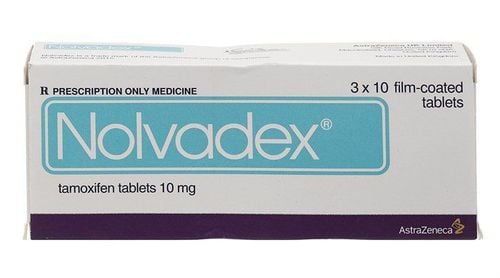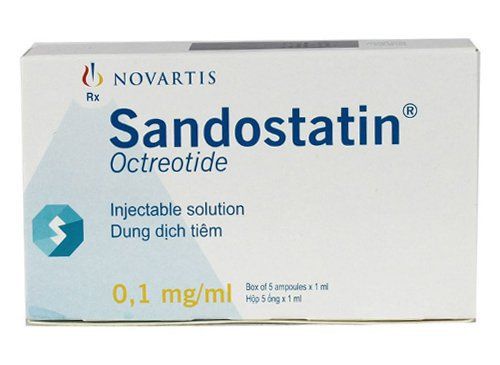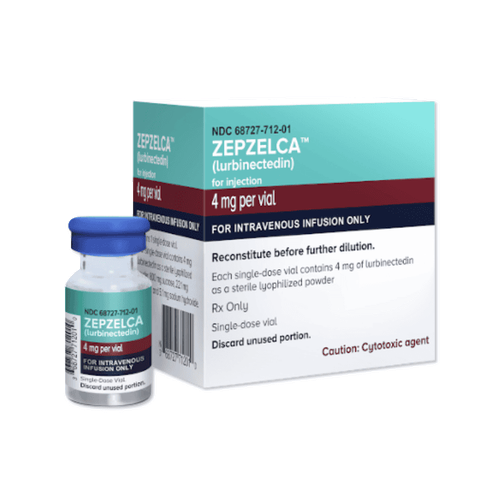This is an automatically translated article.
Paclitaxel belongs to the group of anticancer drugs and is indicated in the treatment of metastatic ovarian cancer, when conventional therapies with anthracyclines and platinum have failed or are contraindicated. The following article will help you better understand the drug Paclitaxel.
1. What disease does paclitaxel treat?
Paclitaxel is isolated from the red pine tree and is on the WHO list of essential medicines. Paclitaxel is marketed under the brand names Onxol, Taxol. Paclitaxel is a chemotherapy drug used in the treatment of many different types of cancer such as breast cancer, ovarian cancer, and non-small cell lung cancer. In addition, this drug is also used in the treatment of Kaposi cancer - a rare cancer associated with people with immunodeficiency syndrome (AIDS).
Its mechanism of action is as follows: Paclitaxel promotes microtubule assembly by enhancing the activity of tubulin dimers. Besides, this chemical also stabilizes existing microtubules and inhibits their cleavage, interferes with the late G2 mitotic phase, and inhibits cell replication.
In addition, the drug can distort the mitotic spindles, leading to chromosome breakage of cancer cells. Paclitaxel can also inhibit cell proliferation and modulate the immune response.
Dosage form: Concentrated solution for intravenous infusion with concentrations of 100 mg/16.7 mL; 30 mg/5 mL; 150 mg/25 mL; 300 mg/50 mL.
2. Usage of the drug Paclitaxel
2.1. How to take Paclitaxel Chemotherapy drugs are usually given on an outpatient basis, sometimes requiring an overnight hospital stay. Before treatment, it is necessary to perform some blood tests such as complete blood count, liver function, kidney function, total coagulation function.., right on the day or a few days before. Patients should be examined first by a physician, specialist nurse, and clinical pharmacist. Administer chemotherapy if blood test results are within acceptable limits.
The medicine is given through a flexible plastic catheter into the jugular vein or the elbow vein.
Before chemotherapy, the patient was given intravenous antiemetics. Some antiemetics can be taken orally.
Antiallergic drugs can be used to prevent hypersensitivity reactions to paclitaxel. Antiallergic drugs are usually given by injection, but can be divided into another portion to take at home before going to the hospital for chemotherapy. The doctor should be informed when the patient is unable to take the medication in advance at home.
Chemotherapy given separately:
Paclitaxel (colorless solution) as a 3-hour drip Carboplatin (colorless solution) is also given by drip over an hour. Chemotherapy session takes about 4-5 hours.
The patient can go home after the infusion is finished.
It is necessary to take a full complement of antiemetics prescribed as outpatients. Antiemetics work better when nausea has not occurred.
2.2. Dosage of the drug Paclitaxel Treatment dose for patients with breast cancer
Adjuvant treatment for patients with breast cancer: intravenous infusion at a dose of 175 mg/m2 for 3 hours, every 3 weeks for 4 cycles.
For patients with breast cancer that has metastasized or recurred: intravenous infusion at a dose of 175 mg / m2 for 3 hours each time, and performed with a frequency of 3 weeks / time.
Dosage for patients with AIDS-related Kaposi sarcoma
Intravenous infusion for patients with AIDS-related Kaposi sarcoma at a dose of 135 mg/m2 every 3 hours, every 3 weeks or at 100 mg/m2 for Every 3 hours at a frequency of every 2 weeks
Due to dose-related toxicity, a dose of 100 mg/m2 may be used in patients with impaired function of the drug metabolism and elimination organs such as liver, kidney...
Dosage for patients with non-small cell lung cancer
Intravenous infusion at a dose of 135 mg/m2 in 24 hours, 3 weeks/time (in combination with cisplatin). Or when combined with other drugs: intravenous infusion of 200 mg/m2, every 3 weeks for 4 cycles (in combination with pembrolizumab and carboplatin) followed by maintenance therapy with pembrolizumab.
Or at a dose of 200 mg/m2 (175 mg/m2 for Asian patients), every 3 weeks for 4 to 6 cycles (in combination with atezolizumab, bevacizumab and carboplatin) followed by maintenance therapy with atezolizumab or bevacizumab.
Treatment dose for advanced (metastatic) ovarian cancer
If the patient was previously treated with paclitaxel, the patient will now receive an intravenous infusion of 135 or 175 mg/m2 in 3 hours, every 3 weeks.
If the patient has not previously been treated with Paclitaxel, the dose will now be: intravenous infusion at a dose of 175 mg/m2 over 3 hours, every 3 weeks (in combination with cisplatin) or 135 mg/m2 for 24 hourly, every 3 weeks (in combination with cisplatin).
2.3. What should you do in case of an emergency or overdose? In the event of an emergency or overdose, immediately call 911 or go to the nearest local medical station.
Symptoms of overdose include:
Pale skin; Short breaths; Tired ; Sore throat, fever, cold and other signs of infection; Unusual bruising and bleeding; Numbness, heat, tingling in the palms of the hands and feet. Pain in the pharynx. 2.4. What should you do if you miss a dose? If you forget to take a dose, take it as soon as possible. However, if it is almost time for your next dose, skip the missed dose and take your next dose at the scheduled time. Do not take twice the prescribed dose.
3. Contraindications of Paclitaxel
Do not use in patients with hypersensitivity to paclitaxel or to any component of the preparation, especially hypersensitivity to Cremophor EL oil. Note that patients are often more or less hypersensitivity to Cremophor EL oil. Do not use for patients with neutrophil count < 1500/mm3 (1.5 x 109/liter) or with obvious motor neuropathy. Pregnant or breastfeeding. Do not use in children under 18 years of age because of the lack of data on safety and effectiveness for these subjects.
4. Precautions when using Paclitaxel
In patients with liver dysfunction or failure. In patients with metabolic cardiovascular disease. In people who are hypersensitive to cremophor EL. The excipient in the preparation is cremophor EL. This substance is more likely to cause anaphylactoid responses by releasing more histamine. Therefore, anaphylaxis prophylaxis should be administered prior to treatment and preparedness for anaphylactic reactions should be prepared. 4.1. Pregnancy Precautions As a general rule, chemotherapy should not be used to treat cancer during pregnancy, especially during the first trimester. The risks to the fetus must be carefully weighed against the benefits and risks to the mother. Paclitaxel is embryo- and fetal-toxic, and reduces fertility in rats.
4.2. Lactation Precautions The concentration of paclitaxel in breast milk is unknown. Therefore, avoid taking paclitaxel while breastfeeding or stopping breastfeeding.
5. Paclitaxel side effects
Possible symptoms of nausea, vomiting, diarrhea, mouth ulcers, muscle/joint pain, numbness/tingling in the knuckles and feet, flushing, dizziness, drowsiness.
If side effects continue to persist or worsen, tell your doctor right away. Temporary hair loss may occur. Hair will grow back to normal once the treatment is over.
This medicine may infrequently cause changes in your blood pressure and heart rate. You should closely monitor changes in the infusion of the drug. Tell your doctor right away if you have dizziness, headache, slow/fast heartbeat, or irregular heartbeat.
Many people using this drug have serious side effects. However, your doctor has prescribed this medicine because they have judged the benefits to you to outweigh the risk of side effects. Close supervision by a doctor is necessary to help reduce the risk of side effects.
Tell your doctor right away if you have any serious side effects, including: signs of anemia (e.g., unusual tiredness, pale skin), easy bruising/bleeding, fainting , confusion, pain/redness/swelling/weakness in arms/legs, calf pain/swelling with warmth, coughing up blood, persistent nausea/vomiting, stomach/abdominal pain, yellow eyes/jaundice, dark urine, vision/hearing changes, seizures.
The drug may infrequently irritate the area where the drug was injected, or the drug may leak out of the vein and irritate the injected area. These effects may cause redness, pain, swelling, discoloration, or unusual skin reactions at the injection site, or when the drug is given 7-10 days later. If the medicine has leaked out of a vein and caused an allergic reaction in the skin, you may not have an allergic reaction in that area if it is given again, even if it is injected into another area. Tell your doctor right away if there are any skin symptoms or abnormalities at the injection site.
Not everyone will experience these side effects. There may also be other side effects, but not mentioned. If you have any questions about side effects, consult your doctor or pharmacist.
6. How to store Paclitaxel?
Store at room temperature, away from moisture and light. Do not store in the bathroom. Do not store in the freezer. Each drug may also have different storage methods. Read the storage instructions on the package carefully, or ask your pharmacist. Keep medicine out of reach of children and pets.
Do not throw medicine in the toilet or in the plumbing unless asked to do so. Dispose of medicine properly when it is expired or unusable. Consult your pharmacist or local waste disposal company on how to safely dispose of your medication.
Please dial HOTLINE for more information or register for an appointment HERE. Download MyVinmec app to make appointments faster and to manage your bookings easily.













